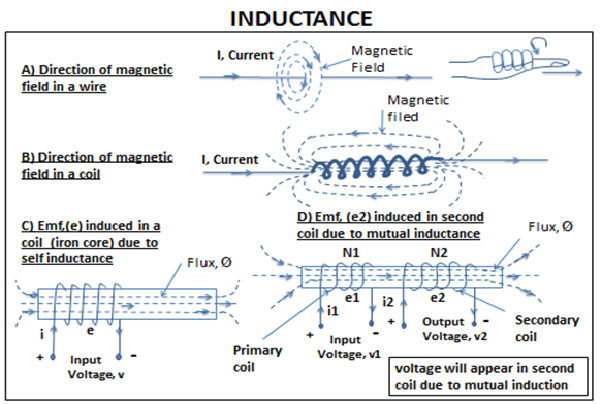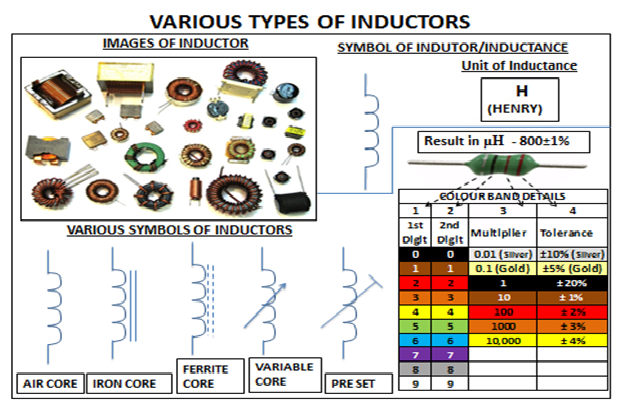Inductance
Definition – Inductance is defined as the property of an electric circuit that produces an emf (electromotive force) with the change of rate of current when ac voltage is applied to the circuit.
This self-induced emf opposes the change of flux linkage. This is explained by following equation –
According to Faraday’s Law – Induced emf, e = – N dØ/dt
Where – e = Induced emf (electromotive force) & the negative sign of the equation indicates that the induced emf opposes the change flux linkage,
N = Number of turns, dØ/dt = rate of change of Flux
Types of Inductance –
There are two types of inductances which are given below –
A) Inductance used in electrical system, B) Inductance used in electronic circuit.
A) Inductance used in electrical system –
There are two types of inductance used in electrical system – 1) Self Inductance & 2) Mutual Inductance
- Self – Inductance – Self- inductance is defined as an emf induced in the same circuit by rate of change of flux when current flows in it. This self- induced emf opposes the circuit voltage (or rate of change of flux linkage). In other words we can say that the emf of self-inductance is proportional to the rate of change of coil current.
Or e ά di/dt
= – L di/dt
= – NKdi/dt (where K = dØ /di, rate of change of flux with respect to current) .
Where L is a self-inductance = a constant = NK (where N – number of turns & K – proportional change, dØ /di). Its unit is Henry.
(Note- A circuit is said to have one henry self-inductance when 1 volt of emf is produced due to rate of change of current through it at one ampere per second current flows in it.)
- Mutual Inductance – The emf induced in the second circuit due to flux linkage from first circuit is known as mutual inductance. In other words we can say – when an alternating current flows through a circuit (or coil) which is placed near to another circuit (or coil), an alternating flux is produced in first circuit. When this flux links with secondary circuit, an emf is induced in the secondary circuit.
According to Faraday’s law, If flux linkage changes with respect to time, an emf is induced in the circuit. Therefore, this effect is called induction effect.

Now, emf induced in second circuit due to current in first circuit can be explained by following equation –
e2 = – M di1/dt Volts,
where-M is Mutual Inductance = N2 dØ /di, N2 = No. of turns of secondary coil,
dØ /di = rate of change of flux with respect to current,
di1/dt = rate of change current with respect to time (ac current) in primary coil.
(Note – Magnetic field describes a region where a magnetic force can be felt,
Magnetic flux describes how much magnetic field passes through an area)
B) Inductance used in electronic circuit –
An inductor (also called an inductance) is circuit element that stores energy during some period of time & returns it during other time, such that the average power is zero. In inductors, energy storage takes place in a magnetic field.

Inductors in Series & Parallel –
Formula for Series & parallel connections of inductances are same of resistances.
Series Connection –
When inductors are connected is series, the equivalent inductance is the sum of the individual inductors’ inductances,
So, total inductance Leq = L1+ L2 + …
Parallel Connection –
When inductors are connected in parallel, the equivalent inductance is calculated by following equation –
Hence, equivalent inductance 1/Leq = 1/L1+ 1/L2+ …. Or Leq = L1L2/ (L1+L2)
Application of Inductance –
Broadly induction phenomenon/effect is generally used in two fields –
1) Electrical field, & 2) Electronic field.
Electrical Field –
Power transformers, Induction Motors, Choke etc work on the principal of Induction effect.
Electronics Field –
- Filters – It is used as a filter for analog circuits & in processing units when used along with capacitors,
- Sensors – It is used as contactless sensors to sense magnetic field or magnetically permeable material from a distance. These are called inductive sensors & used at almost every traffic light intersections to detect the amount of traffic & adjust the sensor accordingly.
- Energy Storage – Inductors can be used for energy store. The main use as energy storage is in switch mode power supplies, like the power supply in PC,
Surface mount Inductors –
These are often used in DC-DC convertor
